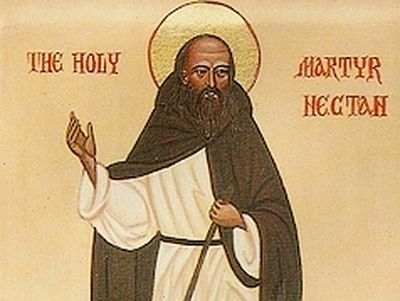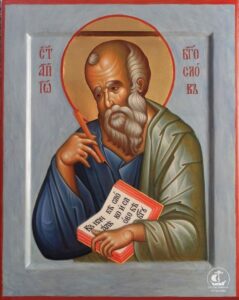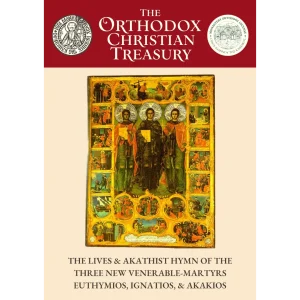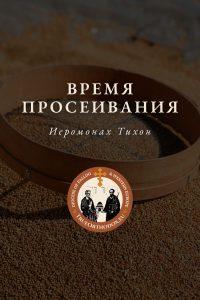SAINT NECTAN, MONK-MARTYR OF HARTLAND AND HIS HOLY SIBLINGS

by Dr. Vladimir Moss
Our holy Father Nectan was born in the fifth century, being the oldest child of Prince Brychan of Brecon in Wales and his wife Gladys. Before begetting Nectan, Brychan went off to live the ascetical life in Ireland but repented of abandoning his wife, and on his return begat a large family of sons and daughters – one for every year that he had unlawfully forsaken the company of his wife. Several of these sons and daughters later founded churches on the North Devon and Cornwall coasts. Inspired by St. Athanasius’ Life of the great Egyptian hermit, St. Anthony, Nectan decided to abandon his father’s house and lead an ascetical life in a foreign land. So, going down to the sea-coast, he entered a boat and committed himself to the Providence of God. Eventually, the boat landed on the North Devon coast near Hartland. Nectan soon found a convenient site for his hermitage, in a wooded, north-sloping valley next to a waterfall, which is now called St. Nectan’s Kieve, near Tintagel. There he constructed a hut out of the branches and bark of trees and set about living a hermit’s life, eating only herbs and acorns and such-like things. Soon news of the holy hermit spread and his brothers and sisters set out to look for him. Having found him, they spread out along the coast, and each built for him or herself a cell in which to live the heremitical life. But every year they all assembled in St. Nectan’s cell on the eve of the Feast of the Circumcision of Christ (January 1). There they conferred together on spiritual subjects and strengthened each other in their zeal for the Heavenly Kingdom. And afterwards, they each returned to his cell mutually edified and rejoicing greatly. Now there lived not far from the saint’s hut a pious man named Huddon. He was a swine-herder, and one day as he was wandering in the woods looking for his lord’s breeding sow with her young, he came upon the hut. Astonished at the sight of the saint, he was at first afraid to approach him. But then, plucking up courage, he went up and spoke to him. He asked him whether he knew anything about the sow and her young. Nectan told him where they were, and the swineherd took the animals and returned them to his master, telling him everything that he had seen and heard. When his master heard the story, he was filled with compassion for the saint in his poverty and went and offered him two good milk-cows. St. Nectan accepted the offering gratefully, allowing himself to depart a little from his voluntary poverty so as not to offend the giver. One day, as the cows were wandering through the woods, seeking richer pastures, two robbers came upon them and stole them. Then the saint set out in search of them and came upon the robbers at a place called Newton. He began speaking to them about the Faith of Christ but was cut short when they attacked and beheaded him. But then a great miracle took place. For, taking his head up in his hands, the saint carried it for about half a mile to his hermitage and laid it all blood-stained on a stone. The traces of the bloodshed by the martyr can still be seen on the stones of the stream in the little valley leading to his hermitage, which is called St. Nectan’s Glen. Meanwhile, the robber who had beheaded him went completely mad, and after tearing his flesh with his nails and biting off his tongue with his teeth, he perished miserably. And the other robber, his accomplice, immediately went almost totally blind. But then, feeling his sight failing, and witnessing the terrible retribution meted out to his companion, he came to repentance. And following as best he could after the martyr as he held his head in his hands, and gathering up the blood from the holy body as it fell to the ground, he felt the progression of his blindness arrested. Glorifying God, he took the body and reverently buried it in the hut near the waterfall. There is a tradition that shortly before his death St. Nectan threw his chapel-bell into the waterfall and prophesied that later when the true faith will have returned to the land, a boy would find it. Much later, sometime in the nineteenth century, some people were drilling through the rock of the waterfall, hoping to find a hidden treasure with the bell. But then they heard a bell tolling and a voice which told them to go no further because the boy who would find the bell had not yet been born… In about the year 937, a young peasant from Hartland was called up to serve in the army of the pious King Athelstan against an invasion from the north led by Olaf, the Viking king of Dublin, and Constantine, king of the Scots. In the night before the battle which has gone down in history as the Battle of Brunanburgh (which was probably in what is now the Wirral), the young man was lying in his lord’s tent, near the king’s pavilion, when he suddenly felt himself seized by the bubonic plague, which at that time was sweeping through the English army. Terrified, he began to weep and groan and call upon God and St. Nectan. So loud were his cries that he disturbed the king and the others who were sleeping in the adjoining tents so that they could not sleep. After midnight St. Nectan appeared to the young man and gently touched the part of his body that was affected. The sick man was immediately cured. In the morning an inquiry was made who had disturbed the king’s rest, and the young man was discovered and brought before the king. When the king saw how frightened he was, he told him not to be afraid but to tell him why he had been shouting so loudly. Then he said: “I felt that this pestilence which is raging among the people had affected me, and I was possessed by uncontrollable grief, thinking that I would die unexpectedly on an expedition in a foreign land. And I began sorrowfully to call upon God and to invoke again and again, among other saints, St. Nectan. And I was heard; for he came to me when I invoked him, touched the part affected by the disease, and drove the whole illness away from me.” The king asked him to recount the life of the martyr. The peasant told the story, and then, plucking up courage, said: “Begging your pardon, my lord king, I want to say that I trust in our Lord Jesus Christ and in the help of His martyr, which I have often experienced. And if you devoutly invoke him and commit yourself to his patronage, by his prayers you will obtain victory over the enemy and drive away the pestilence which is destroying the people.” The king accepted the wise advice of the young man, and promised that he would give the honour to the Lord and St. Nectan if he won the victory and returned safely with his men. God hearkened to the king’s faith, gave him a great victory over his enemies, and removed the deadly plague which had been threatening his army. And so, when he first came to Devon and was informed by his bailiffs that his manor at Hartland was reckoned to contain twenty hides, he gave two hides to the church of the blessed martyr Nectan, and as long as he lived had a special trust in his intercession. During the period of the Danish monarchy, in the early eleventh century, God decreed that the relics of the holy martyr should be revealed. The revelation was made to Brictric, the devout priest of St. Nectan’s church, in the following way. One night, while the priest was sleeping, there appeared to him an angelic man surrounded on every side with glorious light, who said to him: “When it dawns tomorrow, take with you some religious and worthy men and enter the basilica of the blessed martyr Nectan, and in the part which faces north you will find the body of the holy martyr buried. Lift it out of the ground and put it in a more conspicuous position, so that it can be given the highest honour and due reverence by posterity.” The priest awoke and, being a simple soul, waited a little in order that he might prove whether that voice had come from God… And on the following night, the angelic man again appeared to him in his dreams, shining with heavenly light, and warned him to fulfill the command which had been given him. Then Brictric asked and obtained from the Lord that the heavenly vision should appear to him a third time. And so on the third night, as he rested in bed, the heavenly messenger appeared to him again, and first reproved him for not having obeyed. Then he showed him by a sign clearer than that given before where the sepulchre of the holy martyr was. Brictric joyfully went to his local bishop, Livyng of Crediton (1021-1046), and told him the whole story of his vision. But the bishop, despising the poverty of the priest, paid no attention to him. However, Brictric was not to be put off. With unquenched zeal, he returned to his church and summoned all the older persons of both sexes who lived in the parish to come together at that church. And so when a considerable multitude both of clergy and people had assembled, he told them the whole story and ordered that a solemn three days’ fast be observed, in order that God might make his purpose plain to all. At length, the three days’ fast completed, Brictric together with the other priests and a devout multitude of both sexes took candles in their hands and went with the banner of the Cross at their head towards the place indicated in the vision. On arrival, the whole congregation prostrated itself in prayer. Then they arose, cleared the dust away from the pavement and the priests began digging while the rest of the clergy led the people in prayer. For a long time, they laboured without result, and all the priests except Brictric went away to rest a little as if doubting whether their labour would be rewarded. But Brictric, who was taking the leading part in the work, did not leave, but, inspired by most fervent love, zeal and devotion, began digging still more eagerly. Finally, the holy treasure was opened to him that knocked. For by the will of God he found a stone sculpture with figures inscribed on it, which was later placed on the altar built in honour of the martyr near his grave. Then, having taken away the stone which blocked the indenture, he smelled such a sweet fragrance arising from the sepulchre that one would have thought that all the spices and perfumes in the world were contained within it. At the same time, a brilliant light suddenly shone down on them from heaven, dazzling the eyes of all who were present. Then, to the accompaniment of hymns and spiritual songs, they approached the sarcophagus, lifted the holy body from the earth, and placed the holy relics upon the altar consecrated in the name of the martyr. This uncovering of the relics of the holy martyr took place on December 4. Now when Bishop Livyng heard the news, he repented of his unbelief and donated two bells and an immense amount of lead sufficient to roof the whole church, together with a most beautifully worked door. In the sarcophagus, close to the martyr’s body, they found his staff, which the people decorated in gold and silver and precious stones, and a bone seal depicting the bust of the martyr and with the letters SIGILLUM NECTANI inscribed upon it. At the moment of the uncovering of the relics, a blind woman who was nearby, hearing the chanting of the psalms, ran up and asked that she might be led to the holy body. As soon as she put her eyes to the relics of the martyr, she recovered her sight and thanked God. Many other miracles were wrought at that time in the presence of the holy relics. After the death of King Canute in 1035, his son Hardacanute succeeded him on the throne of England. For services rendered in battle, Hardacanute gave the royal manor at Hartland to Earl Godwin. (Godwin was the father of the last English Orthodox king, Harold II, who died at Hastings in 1066, and grandfather of Gytha, the wife of Great-Prince Vladimir Monomakh of Kiev.) However, Hardacanute’s courtiers whispered against Godwin, accusing him of fraud and treason. And so the king decided to destroy Godwin by a cunning stratagem. He gave him some a sealed letter and asked him to take them to Swein, sub-king of Galway. Now while Godwin was on his way to Swein, in the middle of the Irish sea, a great tempest arose. The passengers called upon God and His saints, and each implored the help of his special patron. But as soon as Godwin called on the name of St. Nectan, the sea became calm. Then the earl vowed to pay special honour to the martyr in the future. Meanwhile, Godwin’s servant, a very prudent man, approached him and said: “I have long been silently thinking my lord, that perhaps we are bearing Uriah’s letters with us on this journey.” The earl replied that he could not imagine such a thing of the king. But his servant replied: “With your permission, I will examine the letters in such a way as neither to break the king’s seal nor to smudge the writing.” The earl agreed. The letter read as follows: “King Hardacanute to his relative Swein, greeting. When you have received this letter, take its bearer, Earl Godwin, who has been guilty of devising treachery against me, and secretly put him to death.” At the request of the earl, the servant wrote another letter with the king’s seal: “King Hardacanute to his relative Swein, greeting. I command and entreat you to give the bearer of these presents, my great friend Earl Godwin, the fairest and best of my nieces as a wife.” And so, when Godwin landed, he went to the sub-king, gave him the letter, and within a month married Gytha, and brought her back to England with him. The king was greatly astonished at this outcome, but he went to meet him and greeted him with the kiss of peace. He bestowed many presents upon his niece and treated the earl with the greatest respect as long as he lived. Godwin gave the church of St. Nectan, among other gifts, a mark of gold, with which the martyr’s staff was gilded. And his wife, Countess Gytha, greatly honoured the church, giving it silk palls (there is a stained glass window depicting her in the church). She introduced the clerics Ailman and Lemann and gave them the manor at Hartaton as a place to keep the valuables of the church safe from the Irish pirates. In 1938, the Monophysite Emperor Haile Selassie, who was in exile in England, made the long journey to Hartland in order to pray to St. Nectan and spent a long time prostrate in prayer in the church. After returning to his country, he ruled for a long time and was then killed by the communists in the 1970s. Several local traditions concerning the saint have been preserved to the present day. One of these records that the saint once asked God that if anyone used the name of God in vain in his region, he would be punished in the following way. He would bite on his tongue, the tongue would swell up and nearly choke him, and the swelling would not go down for twelve hours. This gift was granted to him, and there is one recent instance of its exercise. In 1972, Mrs. Olga Mount was staying at her cottage near Hartland with her eldest son and some of his student friends. She told them the story of St. Nectan, and the gift he had received from God to punish those who used the name of God in vain. The next day the students went sightseeing to St. Nectan’s church and holy well, coming back in the evening. The next morning, they were all having breakfast with the exception of one student. Suddenly this student appeared at the top of the stairs, and gestured to the others that he could not speak because his tongue was swollen. The other students laughed, because, as they explained, this student had the previous day mocked St. Nectan’s well and used the name of God in vain. The student then motioned for a piece of paper and wrote down how he had bitten on his tongue during the night. It had swollen quickly, waking him up and nearly choking him. He came out in cold sweat and was thinking of waking up one of the others in his panic when he remembered his idle words of the previous day. Struck with fear, he sat up in bed and meekly asked God to forgive him. The swelling at once ceased to grow, and he sat for the rest of the night waiting for it to go down. The students laughed, but one remarked that he had been very careful with his language the previous day and had been surprised at the other student’s carelessness. After several hours the swelling went down and the suffering student was able to eat his lunch. St. Nectan is commemorated on June 17. His translation took place on December 4. * Several of St. Nectan’s brothers and sisters are also counted among the saints. One of them was St. Clether, whose cell at St. Clether’s on the edge of Bodmin Moor, is one of the best-preserved cells in the Celtic lands. According to a different tradition, he was a prince in Wales who was so impressed by the exploits of St. Brychan in Wales that he became a hermit at Nevern, but later moved to Cornwall. St. Clether is commemorated on November 4. Some miles down the coast from St. Nectan’s is Morwenstow, the church of his sister, St. Morwenna. Nothing is known about her life. There is a well dedicated to the saint overlooking the sea. This is supposed to have arisen when the saint lifted a stone from beneath the cliff for the building of her church – when she put it down the spring arose. Leland the scribe links this church with another Morwenna (or Modwenna) of the ninth century: “Morwenna grew up wise, learned and holy above her generation [at the court of Brychan]. Now it was when she had grown up to saintly womanhood, that Ethelwolf, King of Saxon England, besought King Breachan to send Morwenna to become the teacher of Princess Edith and the other daughters of his house. She came; she sojourned in his palace long years; and so gladdened the King by her goodness and her grace, that at last, he was fain to give her whatsoever she sought. ‘Sir,’ she said, ‘there is a stately headland in far Cornwall, called Hennacliff, or the Raven’s Crag, that I have said my vows, “Would to God that a font and altar might be build among the stones of yonder hill!” Give men then, I beseech thee, My Lord the King, a Stowe for a priest in the scenery of my prayer.’ In the nineteenth century the famously eccentric priest of Morwenstow, Robert Stephen Hawker, claimed to have had a vision of St. Morwenna: “I known that Morwenna lies here: I have seen her, and she has told me as much, and at her feet ere long I hope to lay my old bones.” St. Morwenna is commemorated on July 5. There are early Celtic crosses in the graveyard, and a Saxon font dating to about 950 in the church. Another sister of St. Nectan, St. Endellion (Endelient) lived at Tregony on the milk of a cow, which was killed by the lord of Tregony because it strayed into his grounds. Her godmother caused the death of this lord, but Endellion raised him from the dead. Part of her tomb still survives in St. Endellion’s church in Cornwall, and a church is dedicated to her on Lundy island. Holy Monk-Martyr Nectan, and those with you, pray to God for us! (Sources: 12th century Gotha manuscript translated by G.H. Doble, The Saints of Cornwall, Truro: Holywell Press, part 5, pp. 59-79; R. Pearse Chope, Presidential Address, Devonshire Association Transactions, vol. 58, 1926, p. 52; Robert Hunt, Popular Romances of the West of England, London: Chatto & Windus, 1930, pp. 280-82; Mrs. Olga Mount; David Farmer, The Oxford Dictionary of Saints, Oxford, 1978, pp. 92, 141-142, 310-311, 312; Philip Docton Martyn, Morwenstowe Church, fifth edition, pp. 7, 8; Nick Mayhew Smith, Britain’s Holiest Places, Bristol: Lifestyle Press, 2011, pp. 170-171, 184-185, 196-197, 208-209, 211, 445; Dmitry Lapa, “Holy Martyr Nectan of Hartland”, Pravoslavie.Ru






